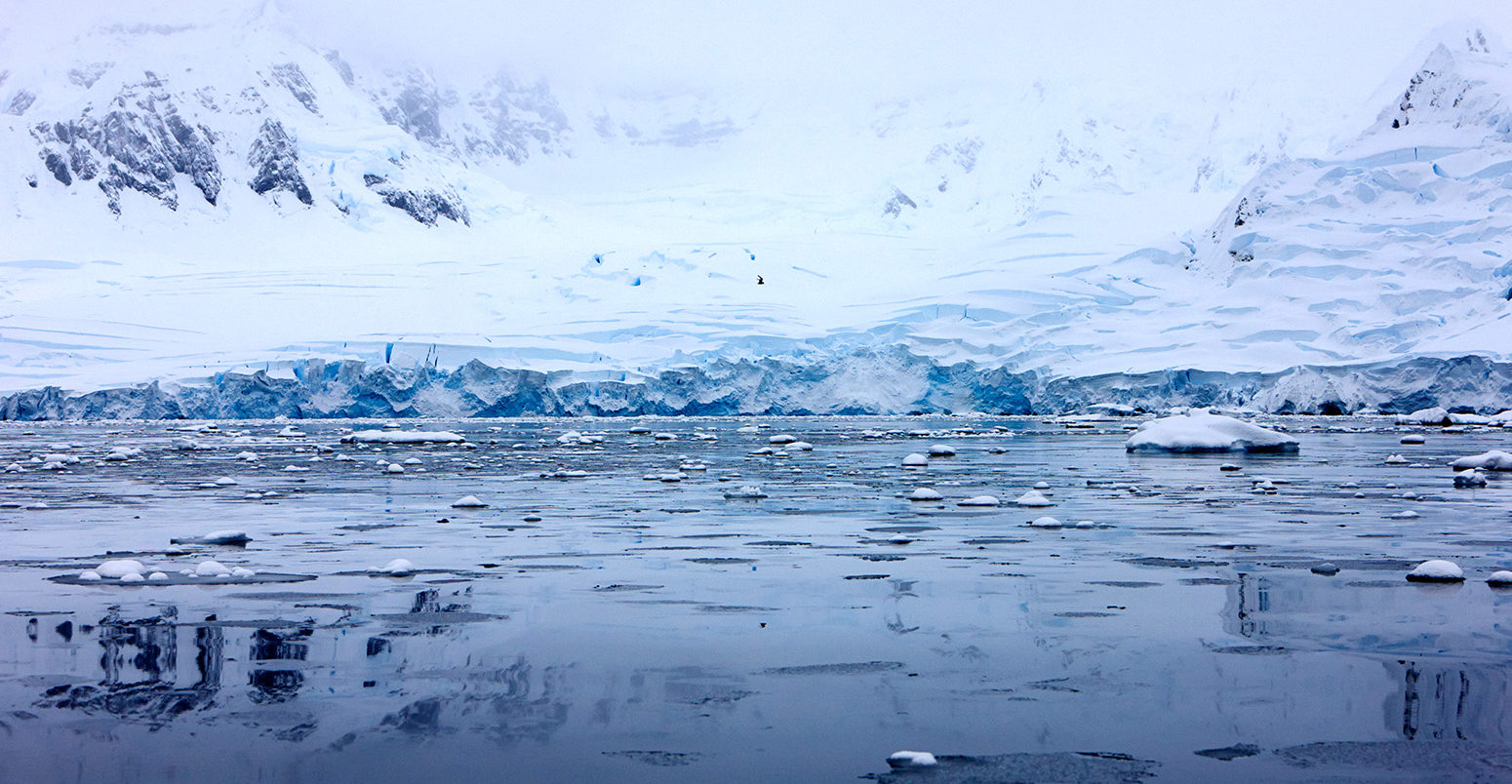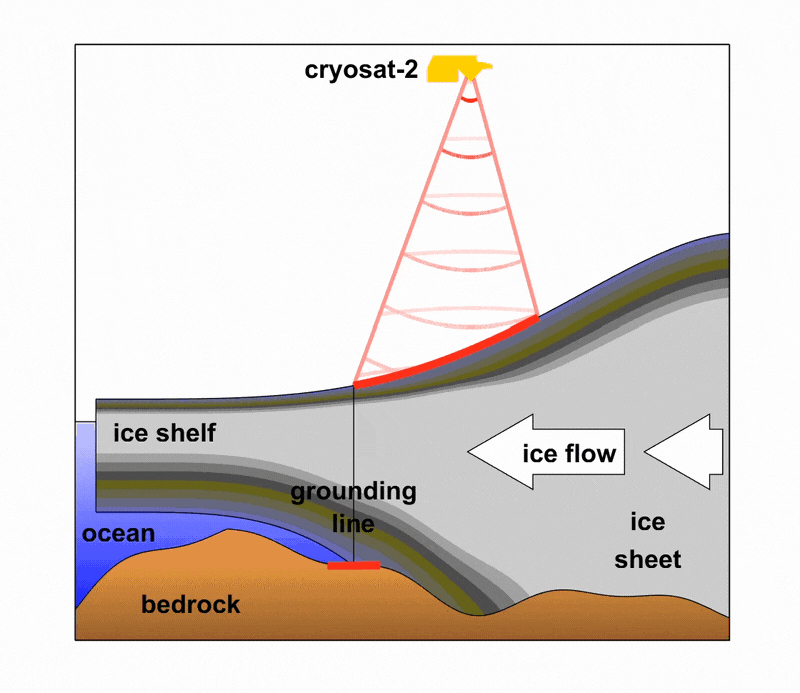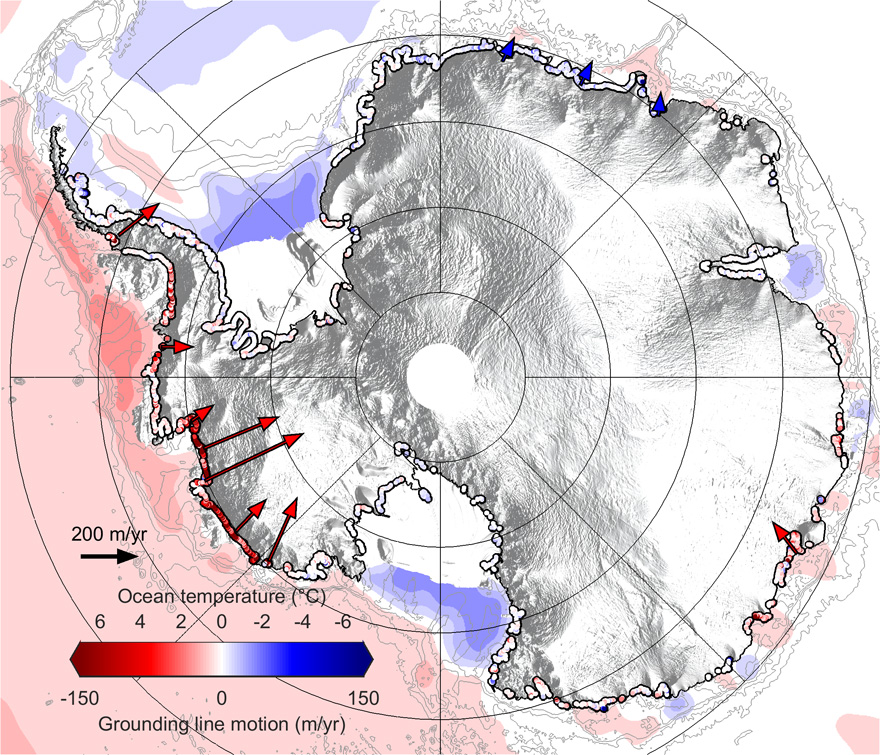
Guest post: Using satellites to track the retreat of Antarctica’s glaciers

Dr Hannes Konrad
04.04.18
Dr Hannes Konrad
04.04.2018 | 11:33amDr Hannes Konrad was formerly a research fellow in the School of Earth and Environment at the University of Leeds and now works at the Alfred Wegener Institute for Polar and Marine Research in Germany.
The long history of the Antarctic Ice Sheet is one of ups and downs. Over millions of years it has responded to ever changing ocean and air temperatures and snowfall as its glaciers have retreated and advanced.
Unlike the long-gone ice sheets that covered large parts of North America and Europe, Antarctica still holds huge volumes of ice even in today’s warm conditions. Its ice also forms by far the largest reservoir of fresh water on the planet – enough to raise global sea levels by about 60 metres if it were to melt.
In a new study, my colleagues and I provide the most complete assessment of Antarctica’s outer glaciers to date, showing that between 2010 and 2016 they lost an area of ice equivalent to the size of Greater London.
A natural frontier of the Antarctic Ice Sheet
Antarctica’s rocky landscape is covered by around 25m cubic kilometres of ice. It has hundreds – if not thousands – of glaciers oozing their way from the continent’s centre out towards its coast.
While these glaciers are many kilometres thick towards the centre of Antarctica, they are much thinner at their lowest end – sometimes called the “toe” or “snout”. As a result, the ones that make it to the ocean will often lift off the ground and float on the surface of the water to form ice shelves.
You can try this yourself with ice cubes and a glass of water. While most ice cubes will float, if the water level is low enough, the larger ones can actually rest on the bottom of the glass.
The distinction between “grounded” and “floating” ice is an important one for glaciologists, because it is only where ice is resting firmly on ground that changes in its size affect global sea levels. This deduction – based on the theory discovered by Greek mathematician Archimedes – is the same that dictates that adding an ice cube to a glass of water will raise the level, but if that ice cube melts, the water won’t rise any further.
Grounded ice is also held back by friction with the rock beneath. In contrast, floating ice glides freely over the water and can gain speed much more easily. The exact point between the floating and grounded parts of a glacier is the so-called “grounding line”, a natural frontier of Antarctica’s glaciers.
Small changes to the glacier can affect how much is lying on the seabed. Returning to the example of an ice cube sitting at the bottom of a glass of water, just a tiny amount of melting (or adding a bit more water) can be enough for it to lift up and begin to float.
So keeping a close eye on glacier grounding lines is a critical aspect of monitoring the health of Antarctica’s glaciers.
Thousands of years of retreat
But pinpointing and tracking grounding lines is easier said than done.
Found at the sea bed, grounding lines are buried underneath huge amounts of ice – often hundreds of metres thick. This means they cannot be identified by simply looking at the ice from above or indeed from any other angle.
There are, however, a number of indirect methods that scientists can use. For example, rising sea levels from melting ice sheets in the northern hemisphere and a warming climate have forced Antarctic glacier grounding lines to retreat since the end of the last ice age around 12,000 years ago. This retreat has left traces in the sediments deposited on the seafloor, from which we can reconstruct how quickly Antarctic ice has melted.
Based on this type of analysis, it appears that the Antarctic grounding line has retreated by an average of around 25 metres per year in active areas over the past thousand years, with occasional periods of more rapid retreat reaching several hundred metres per year.
In recent decades, developments in Earth observations from satellites have provided another tool with which to monitor changes in the Earth’s ice.
For example, scientists use satellites to detect where the ice begins to float by tracking movements due to the influence of ocean tides. Grounding line motion is then detected by comparing two or more of the grounding line positions observed from space.
Using this data, scientists have recorded grounding line retreat as fast as two kilometers per year in places in Antarctica. (It is worth noting that although this is faster than the pace of retreat recorded since the last ice age, satellites are better able to capture short bursts of rapid retreat than methods using seabed sediments.)
Grounding lines today
In our new Nature Geoscience study we use another approach, which relates ice thickness changes to grounding line movement. As an ice shelf thins, more of it lifts off the seabed and begins to float, pulling the grounding line inland. Likewise, if an ice shelf gets thicker, more of it sinks to the seafloor and the grounding line advances.
Using data from the European Space Agency’s CryoSat-2 satellite, we quantify grounding-line movement along a third of Antarctica’s grounding lines, which cover 61 glaciers. This is three times the length and four times the number of glaciers as mapped in previous surveys.
The animation below gives an overview of how we detected grounding line retreat using satellite measurements of ice thickness.

Animation illustrating how horizontal motion of glacier grounding lines is detected using satellite measurements of their elevation change. Credit: Konrad et al. (2018)
Our results show that most grounding lines across Antarctica are in retreat. This is particularly the case in West Antarctica where 22% of grounding lines are retreating at a faster rate than the average speed when the Earth was emerging from the last ice age (25 metres per year). This compares with 3% of grounding lines in East Antarctica and 10% of those at the Antarctic Peninsula.
Overall, the continent lost almost 1,500 square kilometres of “grounded” ice between 2010 and 2016. That’s an area the size of Greater London. For the fastest-flowing glaciers, their grounding lines are retreating by around 110 metres for every metre that the glacier thins near the grounding line.
You can see the changes in the map below, which shows the pace of grounding retreat (red) and advance (blue) between 2010 and 2016. Most of the glaciers in rapid retreat are along the “English Coast” from the tip of the Peninsula to the Ross Sea.
Grounding line retreat in some of these areas is faster than one kilometre a year. However, it appears that the notorious Pine Island Glacier – one of the fastest retreating glaciers around the turn of the millennium – has now stabilised, showing that extreme speeds are not necessarily sustained. The neighbouring Thwaites Glacier, however, is retreating just as quickly as it has been since at least the 1990s.
In East Antarctica we generally see slower motion, somewhat split equally between retreating and advancing grounding lines, and we see that the grounding lines of neighbouring glaciers can easily move in opposite directions.

Map showing rates of grounding line migration and their coincidence with ocean conditions around Antarctica between 2010 and 2016. Seabed temperatures taken from NOAA’s World Ocean Atlas 2013, Volume 1: Temperature. Grounding line locations are from Rignot et al. (2013). Credit: Konrad et al. (2018).
Warm ocean water gnawing at the ice
So what is causing this retreat around the Antarctic ice sheet?
Oceanographic studies have found that warm ocean water is melting the undersides of Antarctica’s ice shelves, gnawing at the ice periodically which eventually forces these glaciers to give way.
It shows how intertwined the various parts of our planet are and how easily things can get out of balance. In this sense, detecting grounding line motion, or changes in Antarctic glaciers in general, often teaches lessons about oceans (or other parts of the system Earth), too, and vice versa.
Scientists know that the Antarctic Ice Sheet has been both bigger and smaller than today in the past. So it is, in principle, not surprising that it is currently moving slowly but steadily away from its current extent.
For coastal communities and low lying islands, though, the path down towards a smaller Antarctic Ice Sheet is worrying as the future pace and scale of decline and related sea level rise remain uncertain.
Konrad, H. et al. (2018) Net retreat of Antarctic glacier grounding lines, Nature Geoscience, doi:10.1038/s41561-018-0082-z
-
Guest post: Using satellites to track the retreat of Antarctica’s glaciers
-
Guest post: What ‘grounding lines’ tell us about Antarctic glacier retreat

